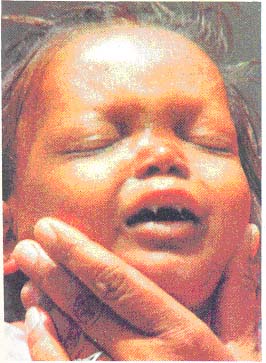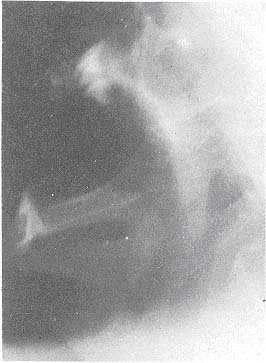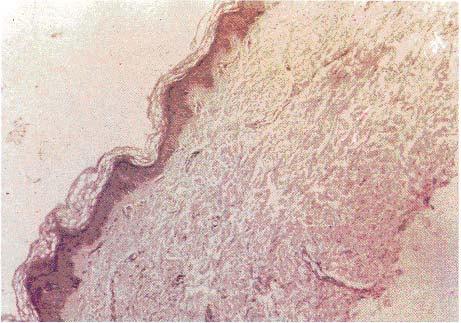A 31/2 year-old girl presented with complaints of fever and heat intolerance along with absence of sweating. The patient was a product of a non-consanguineous
marriage and both the parents and their older 2 children were normal on physical examination. The family history was non contributory.
 |
|
Fig. 1. Front view of the patient showing depressed nasal bridge, peg incisors, periorbital wrinkling and absent eyebrows.
|
Physical examination revealed a girl
with a weight of 8 Kg, height of 83 cm, head circumference of 47 cm, and chest circumference of 45 cm. She had a striking facies with frontal bossing, sparse scalp hair and eye lashes, absent eye brows, depressed nasal bridge, thick everted lips, periorbital wrinkling, and the presence of only two peg shaped upper lateral incisors
(Fig.
1). No moistness was felt over the body and her skin felt unusually soft, smooth and dry. On admission, her axillary
temperature was 38.8"C. The child's systemic examination was normal. The motor and mental development of the child was normal (SQ-103).
 |
|
Fig. 2. Lateral oblique view of mandible showing absence of all teeth roots except upper and lower incisors. |
 |
Fig. 3. Photomicrograph of
skill
biopsy showing thin epithelium and a few rudimentary
sweat glands. |
Investigations revealed a Hb of 8g/ dl and a TLC of 5,800/cu mm. Her renal function tests, serum calcium, phosphorus and alkaline phosphatase
were normal. A lateral oblique view of the mandible revealed absence of all teeth roots except the upper and lower incisors
(Fig.
2). Skin biopsy showed thin epithelium and rudimentary sweat glands and confirmed the diagnosis of hypohydrotic ectodermal dysplasia
(Fig. 3).
Hypohydrotic ectodermal dysplasia is among the rare of 155 syndromes which come under the diverse and phenotypically heterogenous group of inherited disorders called ectodermal dysplasia. Although classically a sex linked disorder, autosomal recessive, autosomal dominant, and even
sporadic cases have been described. The differential diagnosis includes progeroid disorders, congenital hypothyroidism, congenital syphillis, and chronic hypo-parathyroidism.
Tests of sweating can also aid in diagnosis but lack standardization. The
management of these patients is mainly directed towards temperature regulation.
S. Aneja,
A. Seth,
S. Narain,
S. Sethi,
Departments of Pediatrics
and Pathology,
Lady Hardinge Medical College,
New Delhi
110 001.
India.
